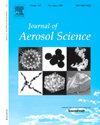Fundamental study of horizontal wind velocity effect on PM2.5 and PM10 sampling accuracy of low-Cost sensors
IF 2.9
3区 环境科学与生态学
Q2 ENGINEERING, CHEMICAL
引用次数: 0
Abstract
Low-cost PM sensors are widely used for air quality monitoring, yet their performance is influenced by many factors such as particle concentration and size, particle properties, relative humidity, and temperature etc. Laboratory and field calibrations are normally needed to correct for the potential bias of sensor readings. However, the effect of ambient wind velocity on the sensor flow rate and the particle sampling efficiency is rarely explored. This study conducted a fundamental study on the impact of horizontal wind velocity on the PM2.5 and PM10 sampling efficiency of low-cost PM sensors in a wind tunnel using NaCl and dust test particles. Results indicated that as wind velocity increased (0.35–3.26 m/s), the sampling flow rate and sampling efficiency of PM2.5 and PM10 decreased for both sensors. To calibrate the effect of the wind velocity on the sampling efficiency, a theoretical prediction model was developed with predicted results in good agreement with the experimental data. To mitigate the influence of horizontal wind velocity on the bias of the sensors, a Multi-Hole Inlet Cover (MHIC) was designed for the PMSX003, and test results showed significant improvement in PM2.5 accuracy while PM10 performance was also enhanced. This study demonstrates that horizontal wind velocity and sampling flow rate are critical factors affecting PM sensor accuracy and a validated model is useful for improving measurement reliability in high-wind conditions. It is also expected that the novel MHIC developed in this work could be used to improve the accuracy of monitoring data and expand its applicability across various environmental conditions.

水平风速对低成本传感器PM2.5和PM10采样精度影响的基础研究
低成本的PM传感器广泛用于空气质量监测,但其性能受到许多因素的影响,如颗粒浓度和大小、颗粒性质、相对湿度和温度等。通常需要实验室和现场校准来纠正传感器读数的潜在偏差。然而,环境风速对传感器流速和粒子采样效率的影响研究却很少。本研究利用NaCl和粉尘测试颗粒,在风洞中进行了水平风速对低成本PM传感器PM2.5和PM10采样效率影响的基础研究。结果表明:随着风速的增大(0.35 ~ 3.26 m/s),两种传感器对PM2.5和PM10的采样流量和采样效率均有所降低;为了校正风速对采样效率的影响,建立了理论预测模型,预测结果与实验数据吻合较好。为减轻水平风速对传感器偏置的影响,在PMSX003上设计了多孔进口盖(MHIC),测试结果表明PM2.5精度显著提高,PM10性能也有所提高。研究表明,水平风速和采样流量是影响PM传感器精度的关键因素,验证的模型有助于提高大风条件下PM传感器的测量可靠性。本研究开发的新型MHIC可用于提高监测数据的准确性,并扩大其在各种环境条件下的适用性。
本文章由计算机程序翻译,如有差异,请以英文原文为准。
求助全文
约1分钟内获得全文
求助全文
来源期刊

Journal of Aerosol Science
环境科学-工程:化工
CiteScore
8.80
自引率
8.90%
发文量
127
审稿时长
35 days
期刊介绍:
Founded in 1970, the Journal of Aerosol Science considers itself the prime vehicle for the publication of original work as well as reviews related to fundamental and applied aerosol research, as well as aerosol instrumentation. Its content is directed at scientists working in engineering disciplines, as well as physics, chemistry, and environmental sciences.
The editors welcome submissions of papers describing recent experimental, numerical, and theoretical research related to the following topics:
1. Fundamental Aerosol Science.
2. Applied Aerosol Science.
3. Instrumentation & Measurement Methods.
 求助内容:
求助内容: 应助结果提醒方式:
应助结果提醒方式:


